Seed Treatment with Electromagnetic Field Induces Different Effects on Emergence, Growth and Profiles of Biochemical Compounds in Seven Half-Sib Families of Silver Birch
Abstract
1. Introduction
2. Results
2.1. EMF Effects on Emergence and Growth of Silver Birch Seedlings
2.2. EMF Effects on Activities of Antioxidant Enzymes
2.3. Antioxidant Activity
2.4. EMF Effect on the Amount of Photosynthetic Pigments
2.5. Secondary Metabolites
2.5.1. Total Polyphenol Content (TPC)
2.5.2. Total Flavonoid Content (TFC)
2.6. Lipid Peroxidation
2.7. Total Soluble Sugars (TSS)
3. Discussion
4. Materials and Methods
4.1. Planting Material
4.2. Seed Treatment with EMFs and Cultivation of Seedlings
4.3. Evaluation of Seedling Emergence and Morphological Parameters
4.4. Collection of Samples for Biochemical Analyses
4.5. Antioxidant Enzymes Analyses
4.5.1. Preparation of Leaf Samples for Antioxidant Enzyme Tests
4.5.2. Total Protein (PROT)
4.5.3. Superoxide Dismutase (SOD)
4.5.4. Guaiacol Peroxidase (POX)
4.5.5. Ascorbate Peroxidase (APX)
4.5.6. Catalase (CAT)
4.5.7. Glutathione Reductase (GR)
4.6. Preparation of Extracts for Analysis of Antioxidant Activity
4.6.1. DPPH (2,2-Diphenyl-1-picryl-hydrazyl-hydrate) Radical Scavenging
4.6.2. ABTS (2,2′-Azino-bis(3-ethylbenzothiazoline-6-sulfonic Acid)) Radical Scavenging
4.7. Preparation of Extracts for Detection of Photosynthetic Pigments, TPC, TFC, Lipid Peroxidation and TSS
4.7.1. Quantification of Chlorophylls a and b and Total Carotenoids
4.7.2. Detection of Total Phenolic Content (TPC)
4.7.3. Detection of Total Flavonoid Content (TFC)
4.7.4. Detection of Lipid Peroxidation (MDA)
4.7.5. Total Soluble Sugars (TSS)
4.8. Statistical Analysis
5. Conclusions
Author Contributions
Funding
Data Availability Statement
Conflicts of Interest
Abbreviations
| ABTS | 2,2′-azino-bis(3-ethylbenzothiazoline-6-sulfonic acid |
| APX | ascorbate peroxidase |
| C | control |
| Caro | carotenoids |
| Chl a | chlorophyll a |
| Chl b | chlorophyll b |
| CP | cold plasma |
| DPPH | 2,2-diphenyl-1-picryl-hydrazyl-hydrate |
| EF | electric field |
| EMF | electromagnetic field |
| GR | glutathione reductase |
| ISR | induced systematic resistance |
| MDA | malondialdehyde |
| MG | magnetic field |
| NADPH | nicotinamide adenine dinucleotide phosphate |
| POX | peroxidase |
| ROS | reactive oxygen species |
| SM | secondary metabolites |
| SOD | superoxide dismutase |
| TFC | total flavonoid content |
| TPC | total phenolic content |
| TSS | total soluble sugars |
References
- Tuskan, G.A.; Difazio, S.; Rokhsar, D. The genome of Black cottonwood, Populus trichocarpa (Torr. & Gray). Science 2006, 313, 1596–1604. [Google Scholar] [CrossRef] [PubMed]
- Food and Agricultural Organization of the United Nations. State of the World’s Forests; United Nations: Rome, Italy, 2003; ISBN 92-5-104865-7. [Google Scholar]
- European Commission. A European Green Deal. Available online: https://ec.europa.eu/info/strategy/priorities-2019-2024/european-green-deal_en (accessed on 28 January 2022).
- Marčiulynas, A.; Sirgedaitė-Šėžienė, V.; Žemaitis, P.; Baliuckas, V. The Resistance of Scots Pine (Pinus sylvestris L.) Half-sib Families to Heterobasidion annosum. Forests 2019, 10, 287. [Google Scholar] [CrossRef]
- Ghelardini, L.; Luchi, N.; Pecori, F. Ecology of invasive forest pathogens. Biol. Invasions 2017, 19, 3183–3200. [Google Scholar] [CrossRef]
- Terhonen, E.; Kovalchuk, A.; Zarsav, A.; Asiegbu, F.O. Biocontrol Potential of Forest Tree Endophytes. In Endophytes of Forest Trees; Springer: Cham, Switzerland, 2018; pp. 283–318. [Google Scholar] [CrossRef]
- Lithuanian State Forest Service. 2021. Available online: https://amvmt.lrv.lt/ (accessed on 14 May 2023).
- Attri, P.; Ishikawa, K.; Okumura, T.; Koga, K.; Shiratani, M. Plasma Agriculture from Laboratory to Farm: A Review. Processes 2020, 8, 1002. [Google Scholar] [CrossRef]
- Tkalec, M.; Malaric, K.; Pavlica, M.; Pevalek-Kozlina, B.; Vidakovic-Cifrek, Ž. Effects of radiofrequency electromagnetic fields on seed germination and root meristematic cells of Allium cepa L. Mutat. Res./Genet. Toxicol. Environ. Mutagen. 2009, 672, 76–81. [Google Scholar] [CrossRef]
- López-Ribera, I.; Vicient, C.M. Use of ultrasonication to increase germination rates of Arabidopsis seeds. Plant. Methods 2017, 13, 31. [Google Scholar] [CrossRef]
- Pournavab, R.F.; Mejía, E.B.; Mendoza, A.B.; Salas Cruz, L.R.; Heya, M.N. Ultraviolet radiation effect on seed germination and seedling growth of common species from Northeastern Mexico. Agronomy 2019, 9, 269. [Google Scholar] [CrossRef]
- Dannehl, D. Effects of electricity on plant responses. Sci. Hortic. 2018, 234, 382–392. [Google Scholar] [CrossRef]
- Pietruszewski, S.; Kania, K. Effect of magnetic field on germination and yield of wheat. Int. Agrophys. 2010, 24, 297–302. [Google Scholar]
- Cramariuc, R.; Donescu, V.; Popa, M.; Cramariuc, B. The biological effect of the electrical field treatment on the potato seed: Agronomic evaluation. J. Electrostat. 2005, 63, 837–846. [Google Scholar] [CrossRef]
- Eing, C.; Bonnet, S.; Pacher, M.; Puchta, H.; Frey, W. Effects of nanosecond pulsed electric field exposure on Arabidopsis thaliana. IEEE Trans. Dielectr. Electr. Insul. 2009, 6, 1322–1328. [Google Scholar] [CrossRef]
- Lynikiene, S.; Pozeliene, A.; Rutkauskas, G. Influence of corona discharge field on seed viability and dynamics of germination. Int. Agrophys. 2006, 20, 195–200. [Google Scholar]
- Maffei, M.E. Magnetic field effects on plant growth, development, and evolution. Front. Plant Sci. 2014, 5, 445. [Google Scholar] [CrossRef] [PubMed]
- Pietrusziewski, S.; Martinez, E. Magnetic field as a method of improving the quality of sowing material: A review. Int. Agrophys. 2015, 29, 377–380. [Google Scholar] [CrossRef]
- Ribeiro-Oliveira, J.P. Electromagnetism and plant development: A new unknown in a known world. Theor. Exp. Plant Physiol. 2019, 31, 423–427. [Google Scholar] [CrossRef]
- Jiang, J.; Lu, Y.; Li, J.; Li, L.; He, X.; Shao, H.; Dong, S. Effect of seed treatment by cold plasma on the resistance of tomato to Ralstonia solanacearum (Bacterial Wilt). PLoS ONE 2014, 9, e97753. [Google Scholar] [CrossRef]
- Panngom, K.; Lee, S.H.; Park, D.H.; Sim, G.B.; Kim, Y.H.; Uhm, H.S.; Park, G.; Choi, E.H.H. Non-thermal plasma treatment diminishes fungal viability and up-regulates resistance genes in a plant host. PLoS ONE 2014, 9, e99300. [Google Scholar] [CrossRef]
- Filatova, I.I.; Azharonok, V.V.; Goncharik, S.V.; Lyushkevich, V.A.; Zhukovsky, A.G.; Gadzhieva, G.I. Effect of rf Plasma Treatment on the Germination and Phytosanitary State of Seed. J. Appl. Spectrosc. 2014, 81, 250–256. [Google Scholar] [CrossRef]
- Mošovská, S.; Medvecká, V.; Halászová, N.; Ďurina, P.; Valík, L.; Mikulajová, A. Cold atmospheric pressure ambient air plasma inhibition of pathogenic bacteria on the surface of black pepper. Food Res. Int. 2018, 106, 862–869. [Google Scholar] [CrossRef]
- Mildažienė, V.; Paužaitė, G.; Naučienė, Z.; Malakauskienė, A.; Žūkienė, R.; Januškaitienė, I.; Jakštas, V.; Ivanauskas, L.; Filatova, I.; Lyushkevich, V. Pre-sowing seed treatment with cold plasma and electromagnetic field increases secondary metabolite content in purple coneflower (Echinacea purpurea) leaves. Plasma Process. Polym. 2018, 15, 1700059. [Google Scholar] [CrossRef]
- Paužaitė, G.; Malakauskienė, A.; Naučienė, Z.; Žūkienė, R.; Filatova, I.; Lyushkevich, V.; Azarko, I.; Mildažienė, V. Changes in Norway spruce germination and growth induced by prie-sowing seed treatment with cold plasma and electromagnetic field: Short-term versus long-term effects. Plasma Process. Polym. 2017, 15, 201700068. [Google Scholar] [CrossRef]
- Beniušytė, E.; Čėsnienė, I.; Sirgedaitė-Šėžienė, V.; Vaitiekūnaitė, D. Genotype-Dependent Jasmonic Acid Effect on Pinus sylvestris L. Growth and Induced Systemic Resistance Indicators. Plants 2022, 12, 255. [Google Scholar] [CrossRef] [PubMed]
- Vallad, G.E.; Goodman, R.M. Systemic Acquired Resistance and Induced Systemic Resistance in Conventional Agriculture. Crop Sci. 2004, 44, 1920–1934. [Google Scholar] [CrossRef]
- Eyles, A.; Bonello, P.; Ganley, R.; Mohammed, C. Induced Resistance to Pests and Pathogens in Trees. New Phytol. 2010, 185, 893–908. [Google Scholar] [CrossRef] [PubMed]
- Heil, M.; Bostock, R.M. Induced Systemic Resistance (ISR) against Pathogens in the Context of Induced Plant Defences. Ann. Bot. 2002, 89, 503–512. [Google Scholar] [CrossRef] [PubMed]
- Zas, R.; Björklund, N.; Nordlander, G.; Cendán, C.; Hellqvist, C.; Sampedro, L. Exploiting Jasmonate-Induced Responses for Field Protection of Conifer Seedlings against a Major Forest Pest, Hylobius Abietis. For. Ecol. Manag. 2014, 313, 212–223. [Google Scholar] [CrossRef]
- Ait Barka, E.; Nowak, J.; Clément, C. Enhancement of Chilling Resistance of Inoculated Grapevine Plantlets with a Plant Growth-Promoting Rhizobacterium, Burkholderia Phytofirmans Strain PsJN. Appl. Environ. Microbiol. 2006, 72, 7246–7252. [Google Scholar] [CrossRef]
- Fedderwitz, F.; Nordlander, G.; Ninkovic, V.; Björklund, N. Effects of Jasmonate-Induced Resistance in Conifer Plants on the Feeding Behaviour of a Bark-Chewing Insect, Hylobius Abietis. J. Pest. Sci. 2016, 89, 97–105. [Google Scholar] [CrossRef]
- Sabbagh, E.; Sabbagh, S.K.; Panjehkeh, N.; Bolok-Yazdi, H.R. Jasmonic Acid Induced Systemic Resistance in Infected Cucumber by Pythium Aphanidermatum. Tarim. Bilim. Derg. 2018, 24, 143–152. [Google Scholar] [CrossRef]
- Sirgedaitė-Šėžienė, V.; Lučinskaitė, I.; Mildažienė, V.; Ivankov, A.; Koga, K.; Shiratani, M.; Laužikė, K.; Baliuckas, V. Changes in Content of Bioactive Compounds and Antioxidant Activity Induced in Needles of Different Half-Sib Families of Norway Spruce (Picea abies (L.) H. Karst) by Seed Treatment with Cold Plasma. Antioxidants 2022, 11, 1558. [Google Scholar] [CrossRef]
- Ganthaler, A.; Stoggl, W.; Mayr, S.; Kranner, I.; Schuler, S.; Wischnitzki, E.; Sehr, E.M.; Fluch, S.; Trujillo-Moya, C. Association genetics of phenolic needle compounds in Norway spruce with variable susceptibility to needle bladder rust. Plant Mol. Biol. 2017, 94, 229–251. [Google Scholar] [CrossRef] [PubMed]
- Devir, Y.H.; Chakrabarty, D.; Ali, M.B.; Hahn, E.J.; Paek, K.Y. Lipid Peroxidation and Antioxidant Enzyme Activities of Euphorbia Millii Hyperhydric Shoots. Environ. Exp. Bot. 2005, 58, 93–99. [Google Scholar] [CrossRef]
- Ahmed, S.; Nawata, E.; Hosokawa, M.; Domae, Y.; Sakuratani, T. Alterations in Photosynthesis and Some Antioxidant Enzymatic Activities of Mungbean Subjected to Waterlogging. Plant Sci. 2002, 163, 117–123. [Google Scholar] [CrossRef]
- Li, B.; Wei, J.; Wei, X.; Tang, K.; Liang, Y.; Shu, K.; Wang, B. Effect of Sound Wave Stress on Antioxidant Enzyme Activities and Lipid Peroxidation of Dendrobium Candidum. Colloids Surf. B Biointerfaces 2008, 63, 269–275. [Google Scholar] [CrossRef] [PubMed]
- Sarraf, M.; Kataria, S.; Taimourya, H.; Santos, L.O.; Menegatti, R.D.; Jain, M.; Ihtisham, M.; Liu, S. Magnetic field (MF) Applications in Plants: An Owerview. Plants 2020, 9, 1139. [Google Scholar] [CrossRef] [PubMed]
- Dhawi, F. Why magnetic fields are used to enhance a plant’s growth and productivity? Annu. Res. Rev. Biol. 2014, 4, 886–896. [Google Scholar] [CrossRef]
- Vian, A.; Davies, E.; Gendraud, M.; Bonnet, P. Plant responses to high frequency electromagnetic fields. BioMed Res. Int. 2016, 2016, 1830262. [Google Scholar] [CrossRef]
- Paiva, S.A.; Russell, R.M. Beta-carotene and other carotenoids as antioxidants. J. Am. Coll. Nutr. 1999, 18, 426–433. [Google Scholar] [CrossRef]
- Racchi, M.L. Antioxidant Defenses in Plants with Attention to Prunus and Citrys spp. Antioxidants 2013, 2, 340–369. [Google Scholar] [CrossRef]
- Striganavičiūtė, G.; Žiauka, J.; Sirgedaitė-Šėžienė, V.; Vaitiekūnaitė, D. Impact of Plant-Associated Bacteria on the In Vitro Growth and Pathogenic Resistance against Phellinus Tremulae of Different Aspen (Populus) Genotypes. Microorganisms 2021, 9, 1901. [Google Scholar] [CrossRef]
- Striganavičiūtė, G.; Žiauka, J.; Sirgedaitė-Šėžienė, V.; Vaitiekūnaitė, D. Priming of Resistance-Related Phenolics: A Study of Plant-Associated Bacteria and Hymenoscyphus Fraxineus. Microorganisms 2021, 9, 2504. [Google Scholar] [CrossRef] [PubMed]
- Bonello, P.; Gordon, T.R.; Herms, D.A.; Wood, D.L.; Erbilgin, N. Nature and Ecological Implications of Pathogen-Induced Systemic Resistance in Conifers: A Novel Hypothesis. Physiol. Mol. Plant Pathol. 2006, 68, 95–104. [Google Scholar] [CrossRef]
- Hynynen, J.; Niemisto, P.; Vihera-Aarnio, A.; Brunner, A.; Hein, S.; Velling, P. Silviculture of birch (Betula pendula Roth and Betula pubescens Ehrh.) in northern Europe. Forestry 2010, 83, 103–119. [Google Scholar] [CrossRef]
- Dubois, H.; Verkasalo, E.; Claessens, H. Potential of birch (Betula pendula Roth and B. pubescens Ehrh.) for forestry and forest-based industry sector within the changing climatic and socio-economic context of Western Europe. Forests 2020, 11, 336. [Google Scholar] [CrossRef]
- Tullus, A.; Rusalepp, L.; Lutter, R.; Rosenvald, K.; Kaasik, A.; Rytter, L.; Kontunen-Soppela, S.; Oksanen, E. Climate and Competitive Status Modulate the Variation in Secondary Metabolites More in Leaves Than in Fine Roots of Betula pendula. Front. Plant Sci. 2021, 12, 746165. [Google Scholar] [CrossRef] [PubMed]
- Mingaila, J.; Čiuldienė, D.; Viškelis, P.; Bartkevičius, E.; Vilimas, V.; Armolaitis, K. The Quantity and Biochemical Composition of Sap Collected from Silver Birch (Betula pendula Roth) Trees Growing in Different Soils. Forests 2020, 11, 365. [Google Scholar] [CrossRef]
- Rastogi, M.; Pandey, M.M.; Rawat, A.K.S. Medicinal plants of the genus Betula-Traditional uses and phytochemical-pharmacological review. J. Ethnopharmacol. 2015, 159, 62–83. [Google Scholar] [CrossRef]
- Deepak, M.; Lihavainen, J.; Keski-Saari, S.; Kontunen-Soppela, S.; Salojärvi, J.; Tenkanen, A.; Heimonen, K.; Oksanen, E.; Keinanen, M. Genotype- and provenance-related variation in the leaf surface secondary metabolites of silver birch. Can. J. For. Res. 2018, 48, 494–505. [Google Scholar] [CrossRef]
- Rishbeth, J. Armillaria in an ancient broadleaved woodland. Eur. J. Plant. Pathol. 2007, 21, 238–249. [Google Scholar] [CrossRef]
- Keča, N.; Koufakis, I.; Dietershagen, J.; Nowakowska, J.A.; Oszako, T. European oak decline phenomenon in relation to climatic changes. Folia For. Pol. Ser. A 2016, 58, 170–177. [Google Scholar] [CrossRef]
- Erwin, D.C.; Ribeiro, O.K. Phytophthora Diseases Worldwide; APS Press: St. Paul, MN, USA, 1996; p. 562. [Google Scholar]
- Brasier, C.M.; Robredo, F.; Ferraz, J.F.P. Evidence for Phytophthora cinnamomi involvement in Iberian oak decline. Plant Pathol. 1993, 42, 140–145. [Google Scholar] [CrossRef]
- Jung, T. Beech decline in Central Europe driven by the interaction between Phytophthora infections and climatic extremes. For. Pathol. 2009, 39, 73–94. [Google Scholar] [CrossRef]
- Orlikowski, L.B.; Oszako, T. Phytophthorosis in Nurseries and Forest Stands; CILP: Warszawa, Poland, 2009. [Google Scholar]
- Nowakowska, J.A.; Stocki, M.; Stocki, N.; Slusarski, S.; Tkaczyk, M.; Caetano, J.M.; Tulik, M.; Hsiang, T.; Oszako, T. Interactions between Phytophthora cactorum, Armillaria gallica and Betula pendula Roth. Seedlings Subjected to Defoliation. Forests 2020, 11, 1107. [Google Scholar] [CrossRef]
- Ivanová, H. Birch necrotic leaf spots caused by fungal pathogens. Folia Oecol. 2014, 41, 134. [Google Scholar]
- Green, S.; MacAskill, G.A. Pathogenicity of Marssonina betulae and other fungi on birch. Plant Pathol. 2007, 56, 242–250. [Google Scholar] [CrossRef]
- Thor, M.; Stenlid, J. Heterobasidion annosum infection of Picea abies following manual or mechanized stump treatment. Scand. J. For. Res. 2004, 20, 154–164. [Google Scholar] [CrossRef]
- Oliva, J.; Bendz-Hellgren, M.; Stenlid, J. Spread of Heterobasidion annosum s.s. and Heterobasidion parviporum in Picea abies 15 years after stump inoculation. FEMS Microbiol. Ecol. 2011, 75, 414–429. [Google Scholar] [CrossRef] [PubMed]
- Singeorzan, S.M.; Holonec, L.; Truta, A.M.; Morar, I.; Dan, C.; Colisar, A.; Viman, O.; Negrusier, C.; Borsai, O.; Criveanu, H.; et al. The Influence of Physical Treatment on Seed Germination and Seedling Development of Spruce (Picea abies [L.] Karst.). Forests 2022, 13, 1498. [Google Scholar] [CrossRef]
- Sirgedaitė-Šėžienė, V.; Mildažienė, V.; Žemaitis, P.; Ivankov, A.; Koga, K.; Shiratani, M.; Baliuckas, V. Long-term response of Norway spruce to seed treatment with cold plasma: Dependence of the effects on the genotype. Plasma Proc. Polym. 2021, 18, 2000159. [Google Scholar] [CrossRef]
- Mildaziene, V.; Pauzaite, G.; Mikalauskiene, A.; Zukiene, R.; Nauciene, Z.; Filatova, I.; Azharonok, V.; Lyushkevic, V. Response of perennial woody plants to seed treatment by electromagnetic field and low-temperature plasma. Bioelectromagnetics 2016, 37, 536–548. [Google Scholar] [CrossRef]
- Kaur, S.; Vian, A.; Chandel, S.; Singh, H.P.; Batish, D.R.; Kohli, R.K. Sensitivity of plants to high frequency electromagnetic radiation: Cellular mechanisms and morphological changes. Rev. Environ. Sci. Biotechnol. 2021, 20, 55–74. [Google Scholar] [CrossRef]
- Ivankov, A.; Zukiene, R.; Nauciene, Z.; Degutyte-Fomins, L.; Filatova, I.; Lyushkevich, V.; Mildaziene, V. The Effects of Red Clover Seed Treatment with Cold Plasma and Electromagnetic Field on Germination and Seedling Growth Are Dependent on Seed Color. Appl. Sci. 2021, 11, 4676. [Google Scholar] [CrossRef]
- Ceccehetti, D.; Pawelek, A.; Wyszkowska, J.; Antoszewski, M.; Szmidt-Jaworskam, A. Treatment of Winter Wheat (Triticum aestivum L.) Seeds with Electromagnetic Field Influences Germination and Phytohormone Balance Depending on Seed Size. Agronomy 2022, 12, 1423. [Google Scholar] [CrossRef]
- Bilalis, D.J.; Katsenios, N.; Efthimiadou, A.; Karkanis, A.; Efthimiadis, P. Investigation of pulsed electromagnetic field as a novel organic pre-sowing method on germination and initial growth stages of cotton. Electromagn. Biol. Med. 2012, 31, 143–150. [Google Scholar] [CrossRef] [PubMed]
- Iqbal, M.; Ahmad, M.R.; Hussain, S.M.; Khera, R.A.; Bokhari, T.H.; Shehzad, M.A. Optimization of pre-sowing magnetic field doses through RSM in pea. Int. Agrophys. 2013, 27, 265–274. [Google Scholar] [CrossRef][Green Version]
- Efthimiadou, E.; Katsenios, N.; KArkanis, A.; Papastylianou, P.; Triantafyllidis, V.; Travlos, I.; Bilalis, D.J. Effects of Presowing Pulsed Electromagnetic Treatment of Tomato Seed on Growth, Yield, and Lycopene Content. Sci. World J. 2014, 2014, 369745. [Google Scholar] [CrossRef] [PubMed]
- Sen, A.; Alikamanoglu, S. Effects of static magnetic field pretreatment with and without PEG 6000 or NaCl exposure on wheat biochemical parameters. Russ. J. Plant Physiol. 2014, 61, 646–665. [Google Scholar] [CrossRef]
- Jiang, X.; Yang, Y.; Feng, S.; Hu, Y.; Cao, M.; Luo, J. Reactive effects of pre-sowing magnetic field exposure on morphological characteristics and antioxidant ability of Brassica juncea in phytoextraction. Chemosphere 2022, 303, 135046. [Google Scholar] [CrossRef]
- Hassanpour, H.; Hassanpour, S. Promoting Impact of Electromagnetic Field on Antioxidant System and Performance of Vascular Tissues in Physalis alkekengi. Russ. J. Plant Physiol. 2021, 68, 545–551. [Google Scholar] [CrossRef]
- Camm, E.L.; Towers, G.H.N. Phenylalanine ammonia lyase. Phytochemistry 1973, 12, 961–973. [Google Scholar] [CrossRef]
- Homayoonzadeh, M.; Moeini, P.; Telebi, K.; Roessner, U.; Hosseininaveh, V. Antioxidant system status of cucumber plants under pesticides treatment. Acta Physiol. Plant. 2020, 42, 161. [Google Scholar] [CrossRef]
- Van den Ende, W. Sugars take a central position in plant growth, development and stress responses. A focus on apical dominance. Front. Plant Sci. 2014, 5, 313. [Google Scholar] [CrossRef] [PubMed]
- Rosa, M.; Prado, C.; Podazza, G.; Interdonato, R.; Gonzalez, J.A.; Hilal, M.; Prado, F. Soluble sugars—Metabolism, sensing and abiotic stress. Plant Signal. Behav. 2009, 4, 388–393. [Google Scholar] [CrossRef] [PubMed]
- Sheen, J.; Zhou, L.; Jang, J.C. Sugars as signaling molecules. Curr. Opin. Plant Biol. 1999, 2, 410–480. [Google Scholar] [CrossRef] [PubMed]
- Siddiqui, H.; Sami, F.; Hayat, S. Glucose: Sweet or bitter effects in plants-a review on current and future perspective. Carbohydr. Res. 2020, 487, 107884. [Google Scholar] [CrossRef] [PubMed]
- Jang, J.H.; Kim, S.H.; Khaine, I.; Kwak, M.J.; Lee, H.K.; Lee, T.Y.; Lee, W.Y.; Woo, S.Y. Physiological changes and growth promotion induced in poplar seedlings by the plant growth-promoting rhizobacteria Bacillus subtilis JS. Photosynthetica 2018, 56, 1188–1203. [Google Scholar] [CrossRef]
- Kumar, V.; Kumar, M.; Sharma, S.; Prasad, R. Probiotics and Plant Health; Springer: Singapore, 2017. [Google Scholar]
- Havaux, M. Carotenoid oxidation products as stress signals in plants. Plant J. 2014, 79, 597–606. [Google Scholar] [CrossRef] [PubMed]
- Nisar, N.; Li, L.; Lu, S.; Khin, N.C.; Pogson, B.J. Carotenoid metabolism in plants. Mol. Plant 2015, 8, 68–82. [Google Scholar] [CrossRef]
- Srivastava, R. Physicochemical, antioxidant properties of carotenoids and its optoelectronic and interaction studies with chlorophyll pigments. Sci. Rep. 2021, 11, 18365. [Google Scholar] [CrossRef]
- He, L.; He, T.; Farrar, S.; Ji, L.; Liu, T.; Ma, X. Antioxidants Maintain Cellular Redox Homeostasis by Elimination of Reactive Oxygen Species. Cell. Physiol. Biochem. 2017, 44, 532–553. [Google Scholar] [CrossRef]
- Terpinic, P.; Polak, T.; Segatin, N.; Hanzlowsky, A.; Ulrih, N.P.; Abrovič, H. Antioxidant properties of 4-vinyl derivatives of hydroxycinnamic acids. Food Chem. 2011, 128, 62–90. [Google Scholar] [CrossRef] [PubMed]
- Guderjan, M.; Elez-Martinez, P.; Knorr, D. Application of pulsed electric fields at oil yield and content of functional food ingredients at the production of rapeseed oil. Innov. Food Sci. Emerg. Technol. 2007, 8, 55–62. [Google Scholar] [CrossRef]
- Chaharsoughi, S.M.; Amjad, L.; Dehkordi, M.K. Effects of Electromagnetic Fields on Seed Germination and Weight, Phenol and Flavonoid Content and Antioxidant System of Portulaca oleracea. Adv. Biores. 2016, 7, 100–108. [Google Scholar]
- Sasidharan, S.; Aravindran, S.; Latha, L.Y.; Vijenhti, R.; Saravanan, D.; Amutha, S. In vitro antioxidant activity and hepatoprotective effects of Lentinula edodes against paracetamol-induced hepatotoxicity. Molecules 2010, 15, 4478–4489. [Google Scholar] [CrossRef] [PubMed]
- Feng, L.; Jia, X.; Zhu, M.M.; Chen, Y.; Shi, F. Antioxidant Activities of Total Phenols of Prunella vulgaris L. in vitro and in Tumor-bearing Mice. Molecules 2010, 15, 9145–9156. [Google Scholar] [CrossRef] [PubMed]
- Ling, L.; Jiangang, L.; Minchong, S.; Chunlei, Z.; Yuanhua, D. Cold plasma treatment enhances oilseed rape seed germination under drought stress. Sci. Rep. 2015, 5, 13033. [Google Scholar] [CrossRef] [PubMed]
- Li, Y.; Wang, T.; Meng, Y.; Qu, G.; Sun, Q.; Liang, D.; Hu, S. Air Atmospheric Dielectric Barrier Discharge Plasma Induced Germination and Growth Enhancement of Wheat Seed. Plasma Chem. Plasma Process. 2017, 37, 1621–1634. [Google Scholar] [CrossRef]
- Guo, Q.; Wang, Y.; Zhang, H.; Qu, G.; Wang, T.; Sun, Q.; Liang, D. Alleviation of adverse effects of drought stress on wheat seed germination using atmospheric dielectric barrier discharge plasma treatment. Sci. Rep. 2017, 7, 16680. [Google Scholar] [CrossRef]
- Adhikari, B.; Adhikari, M.; Ghimire, B.; Adhikari, B.C.; Park, G.; Choi, E.H. Cold plasma seed priming modulates growth, redox homeostasis and stress response by inducing reactive species in tomato (Solanum lycopersicum). Free Radic. Biol. Med. 2020, 156, 57–69. [Google Scholar] [CrossRef]
- Starič, P.; Vogel-Mikuš, K.; Mozetič, M.; Junkar, I. Effects of Nonthermal Plasma on Morphology, Genetics and Physiology of Seeds: A Review. Plants 2020, 9, 1736. [Google Scholar] [CrossRef]
- Panche, A.N.; Diwan, A.D.; Chandra, S.R. Flavonoids: An overview. J. Nutr. Sci. 2016, 5, e47. [Google Scholar] [CrossRef] [PubMed]
- Dias, M.C.; Pinto, D.; Silva, A.M.S. Plant Flavonoids: Chemical Characteristics and Biological Activity. Molecules 2021, 26, 5377. [Google Scholar] [CrossRef] [PubMed]
- Degutyte-Fomins, L.; Paužaite, G.; Žukiene, R.; Mildažiene, V.; Koga, K.; Shiratani, M. Relationship between cold plasma treatment-induced changes in radish seed germination and phytohormone balance. Jpn. J. Appl. Phys. 2020, 59, SH1001. [Google Scholar] [CrossRef]
- Schützendübel, A.; Schwanz, P.; Teichmann, T.; Gross, K.; Langenfeld-Heyser, R.; Godbold, D.L.; Polle, A. Cadmium-induced changes in antioxidative systems, hydrogen peroxide content, and differentiation in Scots pine roots. Plant Physiol. 2001, 127, 887–898. [Google Scholar] [CrossRef] [PubMed]
- Singleton, V.L.; Orthhofer, R.; Lamuela-Raventos, R.M. Analysis of Total Phenols and Other Oxidation Substrates and Antioxidants by Means of Folin-Ciocalteu Reagent. Methods Enzymol. 1974, 299, 152–178. [Google Scholar] [CrossRef]
- Bradford, M.M. A Rapid and Sensitive Method for the Quantitation Microgram Quantities of Protein Utilizing the Principle of Protein-Dye Binding. Anal. Biochem. 1976, 72, 248–254. [Google Scholar] [CrossRef] [PubMed]
- Dhindsa, R.S.; Plumb-Dhindsa, P.; Thorpe, T.A. Leaf Senescence: Correlated with Increased Levels of Membrane Permeability and Lipid Peroxidation, and Decreased Levels of Superoxide Dismutase and Catalase. J. Exp. Bot. 1981, 32, 93–101. [Google Scholar] [CrossRef]
- DeAngelis, K.M. Phosphate Buffer Preparation. Available online: https://www.unl.edu/cahoonlab/phosphate%20buffer.pdf (accessed on 15 January 2023).
- Kar, M.; Mishra, D. Catalase, Peroxidase, and Polyphenoloxidase Activities during Rice Leaf Senescence. Plant Physiol. 1976, 57, 315–319. [Google Scholar] [CrossRef]
- Wu, Y.X.; von Tiedemann, A. Impact of Fungicides on Active Oxygen Species and Antioxidant Enzymes in Spring Barley (Hordeum vulgare L.) Exposed to Ozone. Environ. Pollut. 2002, 116, 37–47. [Google Scholar] [CrossRef]
- Cakmak, I.; Marschner, H. Magnesium Deficiency and High Light Intensity Enhance Activities of Superoxide Dismutase, Ascorbate Peroxidase, and Glutathione Reductase in Bean Leaves. Plant Physiol. 1992, 98, 1222–1227. [Google Scholar] [CrossRef]
- Nakano, Y.; Asada, K. Hydrogen Peroxide Is Scavanged by Ascorbate-Specific Peroxidase in Spinach Chloroplasts. Plant Cell Physiol. 1981, 22, 867–880. [Google Scholar] [CrossRef]
- Smith, I.K.; Vierheller, T.L.; Thorne, C.A. Assay of Glutathione Reductase in Crude Tissue Homogenates Using 5,5′-Dithiobis(2-Nitrobenzoic Acid). Anal. Biochem. 1988, 175, 408–413. [Google Scholar] [CrossRef] [PubMed]
- Ragaee, S.; Abdel-Aal, E.S.M.; Noaman, M. Antioxidant Activity and Nutrient Composition of Selected Cereals for Food Use. Food Chem. 2006, 98, 32–38. [Google Scholar] [CrossRef]
- Xiao, F.; Xu, T.; Lu, B.; Liu, R. Guidelines for antioxidant assays for food components. Food Front. 2020, 1, 60–69. [Google Scholar] [CrossRef]
- Re, R.; Pallergini, N.; Proteggente, A.; Pannala, A.; Yang, M.; Rice-Evans, C. Antioxidant activity applying an improved ABTS radical cation decolorization assay. Free Radic. Biol. Med. 1999, 22, 1231–1237. [Google Scholar] [CrossRef] [PubMed]
- Lichtenthaler, H.K.; Buschmann, C. Chlorophylls and Carotenoids: Measurement and Characterization by UV-VIS Spectroscopy. Curr. Protoc. Food Anal. Chem. 2001, 1, F4.3.1–F4.3.8. [Google Scholar] [CrossRef]
- Lowry, O.H.; Rosebrough, N.J.; Farr, A.L.; Randall, R.J. Protein Measurement with the Folin Phenol Reagent. J. Biol. Chem. 1951, 193, 265–275. [Google Scholar] [CrossRef]
- Chang, C.C.; Yang, M.H.; Wen, H.M.; Chern, J.C. Estimation of Total Flavonoid Content in Propolis by Two Complementary Colometric Methods. J. Food Drug Anal. 2002, 10, 178–182. [Google Scholar] [CrossRef]
- Mensah, P.K.; Palmer, C.G.; Muller, W.J. Lipid peroxidation in the freshwater shrimp Caridina nilotica as a biomarker of Roundup® herbicide pollution of freshwater systems in South Africa. Water Sci. Technol. 2012, 65, 1660–1666. [Google Scholar] [CrossRef]
- Murshed, R.; Lopez-Lauri, F.; Sallanon, H. Effect of water stress on antioxidant systems and oxidative parameters in fruits of tomato (Solanum lycopersicon L., cv. Micro-tom). Physiol. Mol. Biol. Plants 2013, 19, 363–378. [Google Scholar] [CrossRef]
- Murshed, R.; Lopez-Lauri, F.; Keller, C.; Monnet, F.; Sallanon, H. Acclimation to drought stress enhances oxidative stress tolerance in Solanum lycopersicum L. fruits. Plant Stress 2008, 2, 145–151. [Google Scholar]
- Leyva, A.; Quintana, A.; Sánchez, M.; Rodríguez, E.N.; Cremata, J.; Sánchez, J.C. Rapid and sensitive anthrone–sulfuric acid assay in microplate format to quantify carbohydrate in biopharmaceutical products: Method development and validation. Biologicals 2008, 36, 134–141. [Google Scholar] [CrossRef]
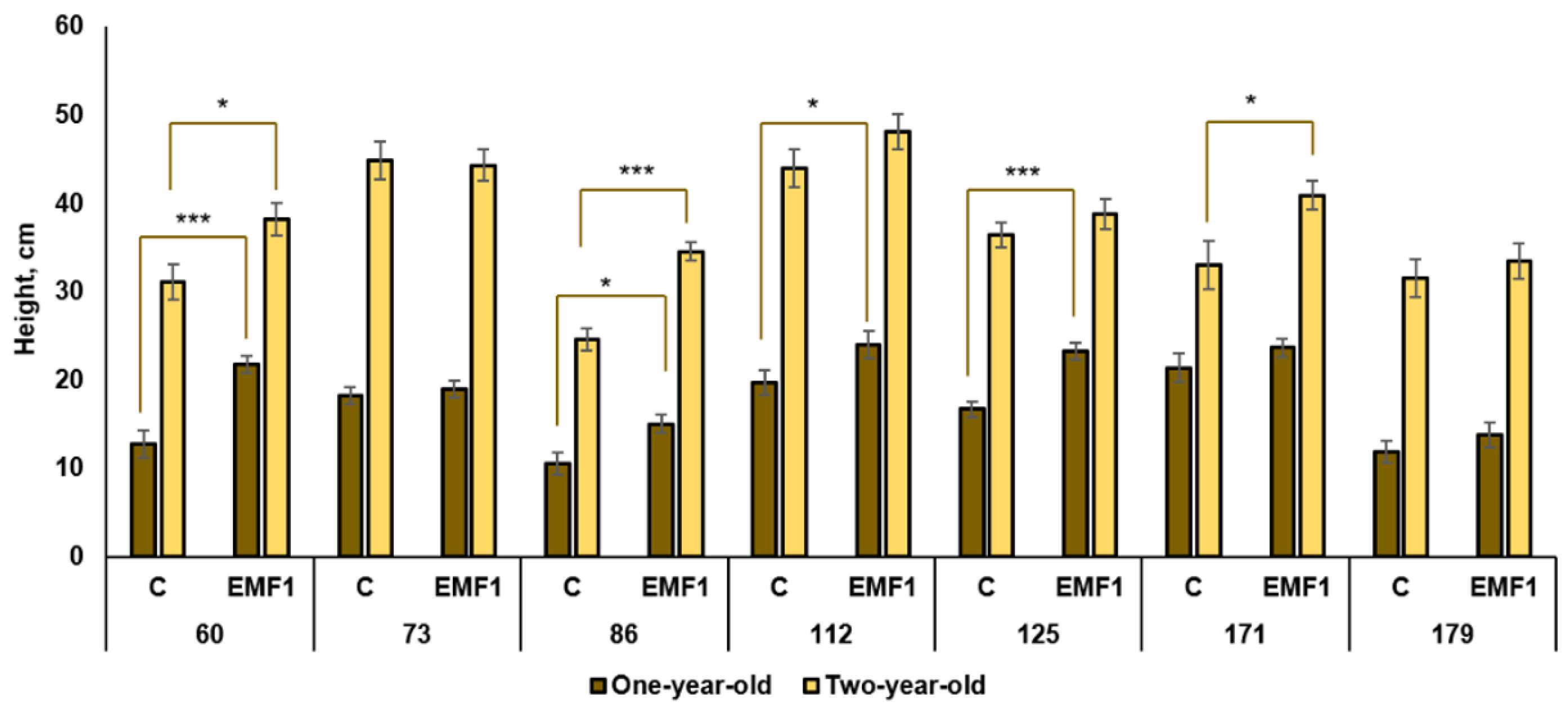



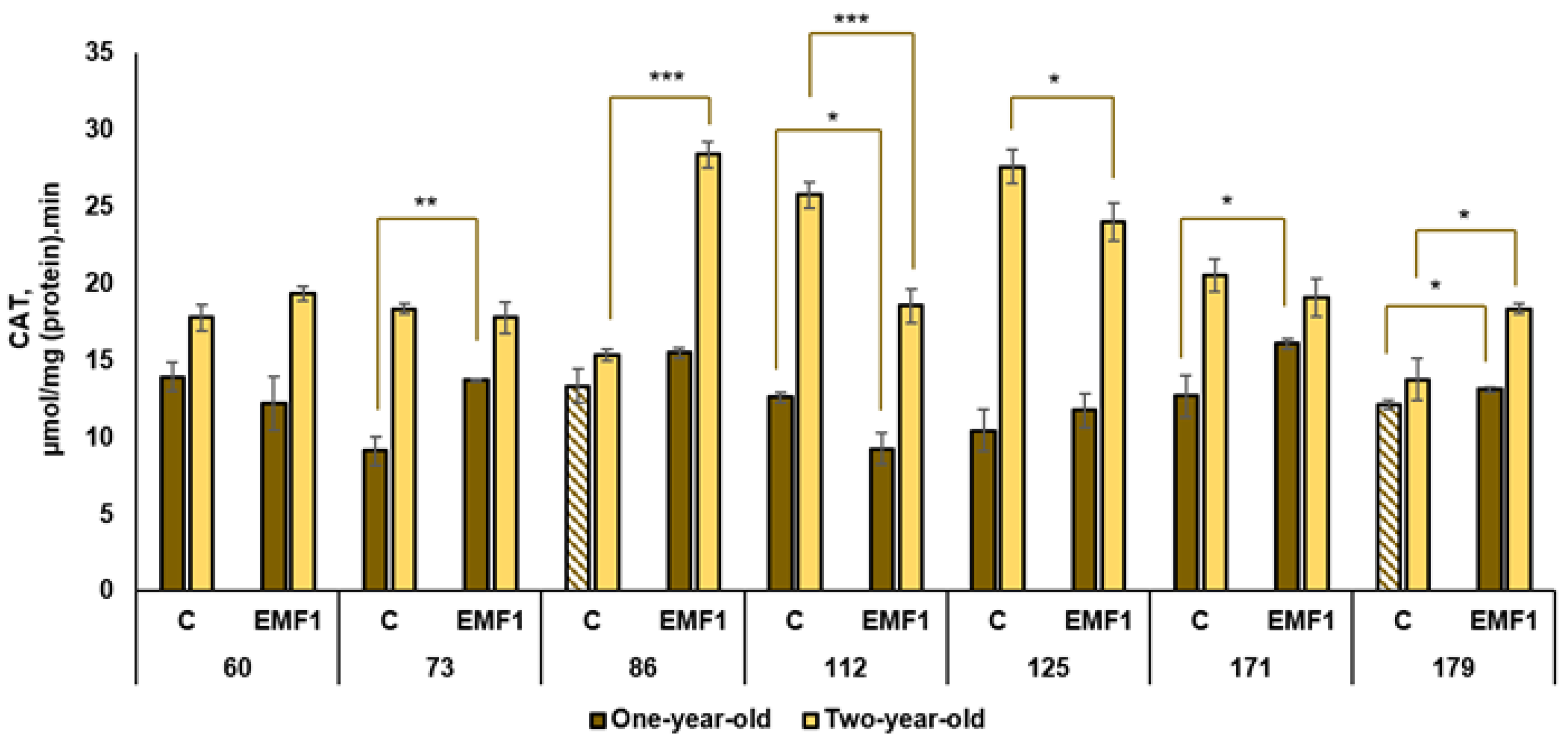



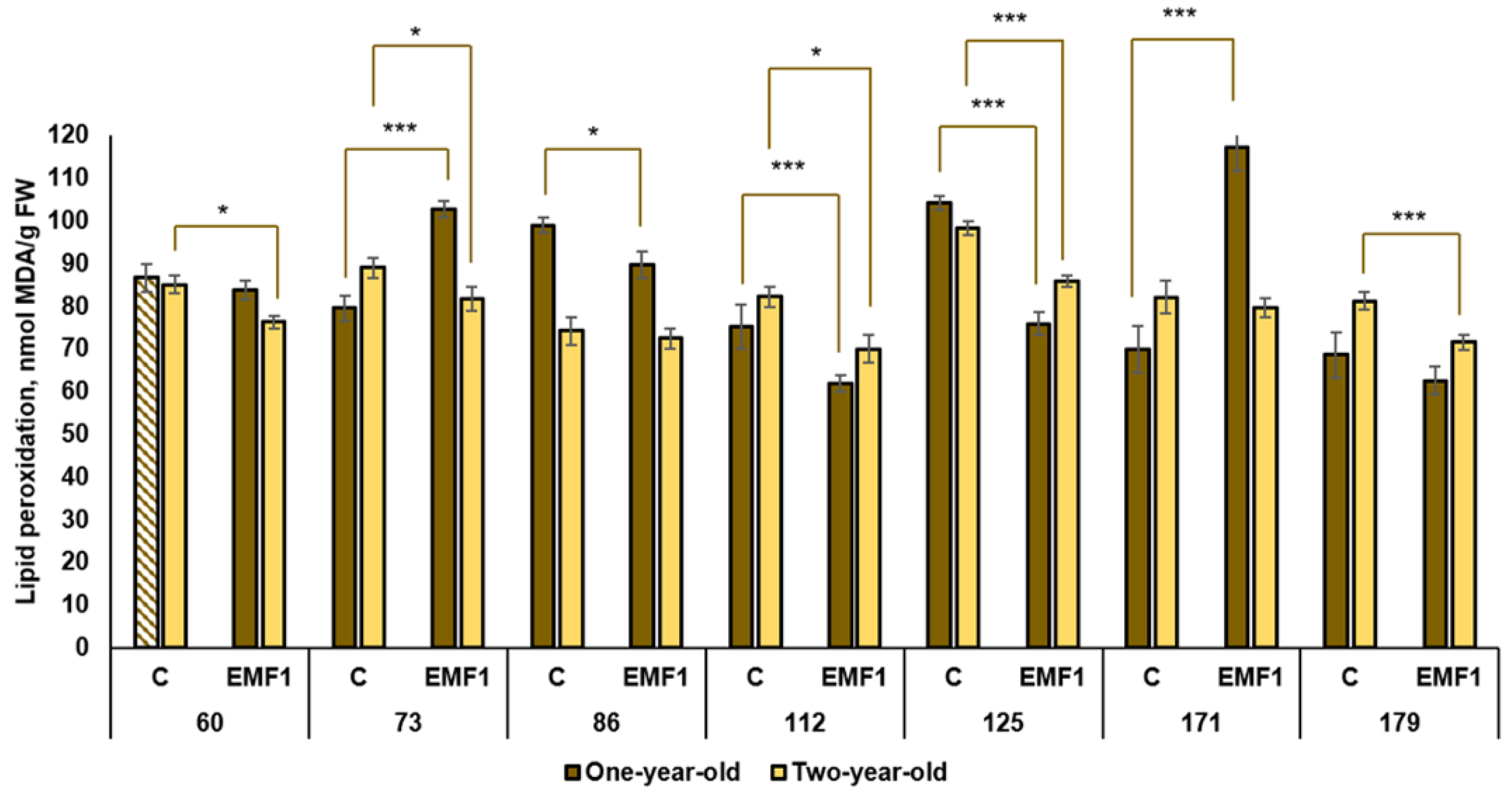
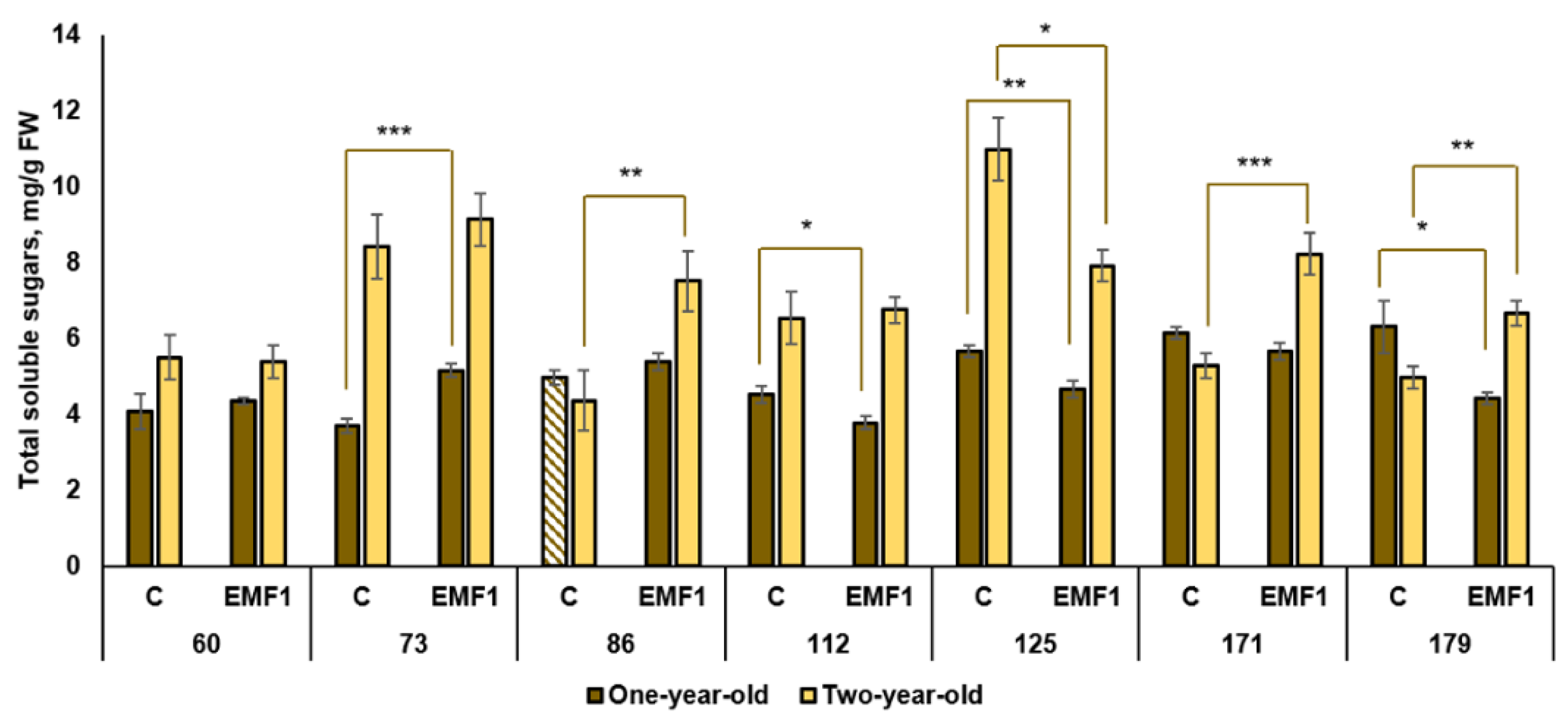
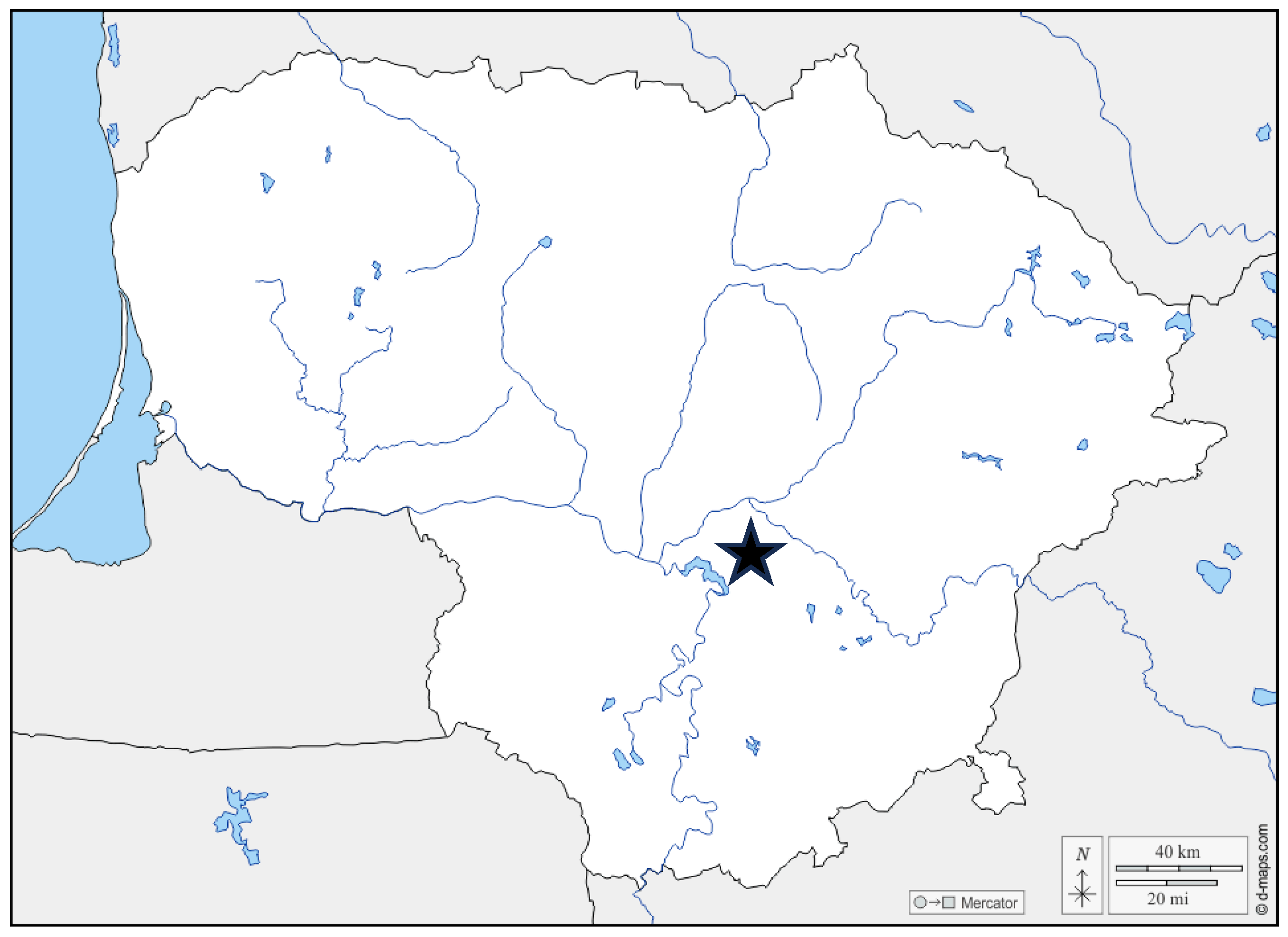

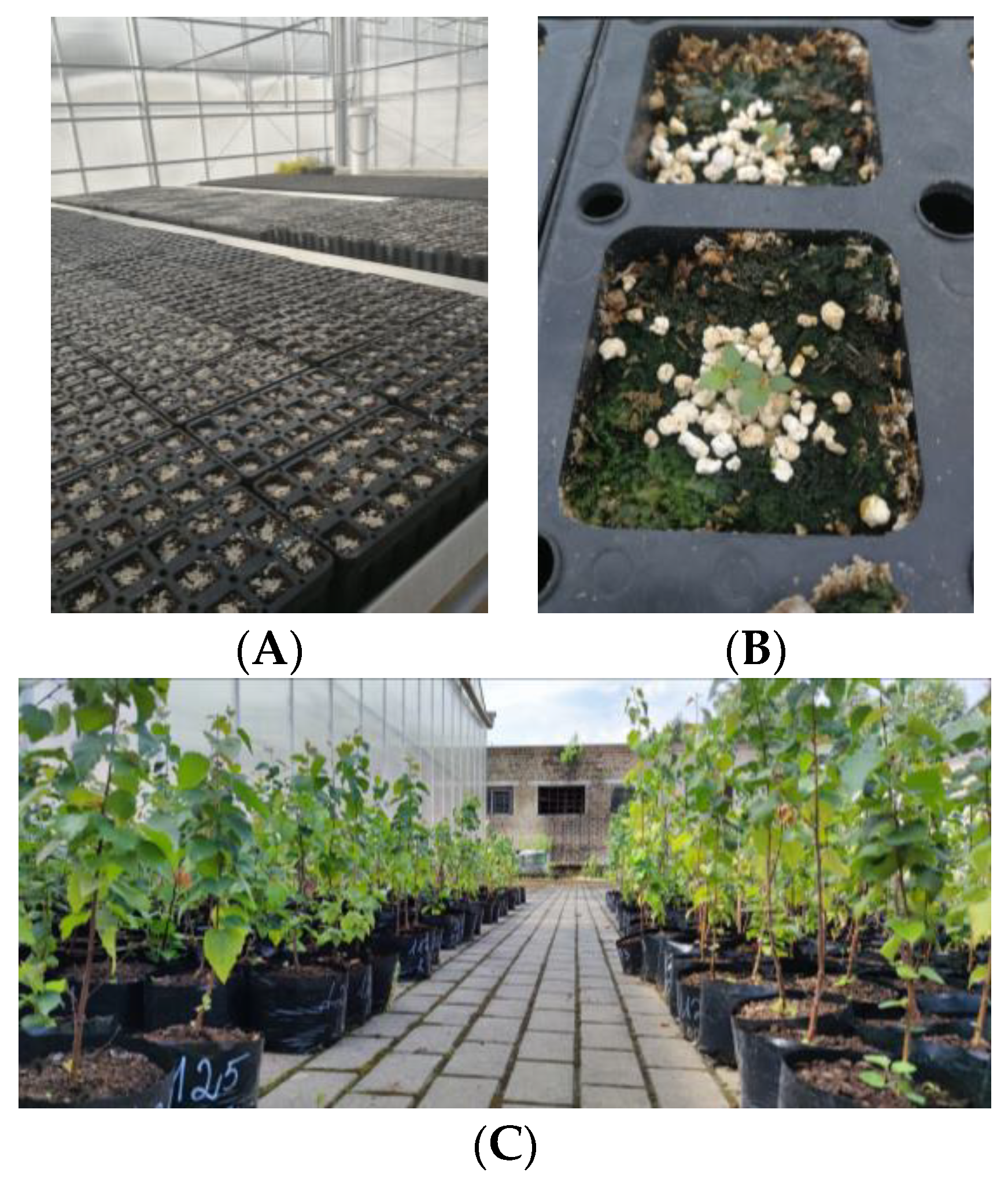
| Half-Sib Family | Treatment | Emergence (%) ± SE |
|---|---|---|
| 60 | C | 2.31 ± 0.01 |
| EMF1 | 7.87 ± 0.02 ** | |
| 73 | C | 16.67 ± 0.03 |
| EMF1 | 17.59 ± 0.03 | |
| 86 | C | 3.24 ± 0.01 |
| EMF1 | 3.70 ± 0.01 | |
| 112 | C | 6.02 ± 0.02 |
| EMF1 | 11.11 ± 0.02 | |
| 125 | C | 10.65 ± 0.02 |
| EMF1 | 6.94 ± 0.02 | |
| 171 | C | 4.17 ± 0.01 |
| EMF1 | 7.87 ± 0.02 | |
| 179 | C | 3.7 ± 0.01 |
| EMF1 | 4.86 ± 0.01 |
| Radical Scavenging Activity, µmol/g, ±SE | |||||
|---|---|---|---|---|---|
| One-Year-Old | Two-Year-Old | ||||
| Half-Sib Family | Treatment | DPPH | ABTS | DPPH | ABTS |
| 60 | C | 331.5 ± 17.1 | 370.0 ± 29.7 | 549.2 ± 12.1 | 982.7 ± 31.2 |
| EMF1 | 643.2 ± 82.5 ** | 607.0 ± 49.4 ** | 540.5 ± 15.3 | 914.1 ± 51.2 | |
| 73 | C | 225.0 ± 33.4 | 337.8 ± 24.2 | 551.6 ± 14.2 | 1163.4 ± 25.3 |
| EMF1 | 283.5 ± 14.8 | 546.9 ± 19.0 *** | 529.5 ± 23.6 | 951.8 ± 19.8 *** | |
| 86 | C | 421.0 ± 43.5 | 523.9 ± 31.1 | 540.6 ± 11.4 | 1084.5 ± 17.4 |
| EMF1 | 331.8 ± 14.9 | 405.1 ± 18.8 ** | 554.9 ± 8.9 | 1222.3 ± 24.4 *** | |
| 112 | C | 346.1 ± 11.3 | 413.9 ± 35.5 | 607.0 ± 9.1 | 1274.9 ± 23.5 |
| EMF1 | 303.3 ± 14.8 * | 382.6 ± 10.5 | 563.3 ± 9.9 ** | 1154.9 ± 19.7 ** | |
| 125 | C | 400.3 ± 14.6 | 534.9 ± 28.0 | 596.8 ± 8.5 | 1341.6 ± 39.3 |
| EMF1 | 456.2 ± 20.4 * | 556.5 ± 54.4 | 586.6 ± 11.4 | 1317.1 ± 25.5 | |
| 171 | C | 1025.4 ± 14.7 | 686.9 ± 41.4 | 615.7 ± 19.7 | 1382.3 ± 24.2 |
| EMF1 | 322.0 ± 35.6 *** | 636.5 ± 56.4 | 597.0 ± 15.5 | 1289.4 ± 17.6 ** | |
| 179 | C | 426.4 ± 21.5 | 615.5 ± 23.3 | 612.9 ± 20.5 | 1125.9 ± 13.2 |
| EMF1 | 356.4 ± 20.4 * | 518.4 ± 48.1 | 555.6 ± 27.5 | 1071.2 ± 19.4 * | |
| Half-Sib Family | Treatment | Photosynthetic Pigment Content (μg/g), ±SE | |||||
|---|---|---|---|---|---|---|---|
| One-Year-Old | Two-Year-Old | ||||||
| Chl a | Chl b | Caro | Chl a | Chl b | Caro | ||
| 60 | C | 208.04 ± 27.49 | 101.60 ± 10.78 | 14.49 ± 0.22 | 255.72 ± 21.90 | 216.65 ± 8.72 | 66.05 ± 3.44 |
| EMF1 | 325.35 ± 21.15 ** | 148.16 ± 8.99 *** | 15.56 ± 0.15 *** | 637.03 ± 26.83 *** | 416.61 ± 14.54 *** | 49.97 ± 1.16 ** | |
| 73 | C | 244.58 ± 7.42 | 120.29 ± 3.07 | 15.10 ± 0.06 | 256.83 ± 9.64 | 196.18 ± 5.90 | 61.70 ± 2.10 |
| EMF1 | 387.62 ± 8.97 *** | 180.67 ± 3.82 *** | 15.27 ± 0.04 * | 332.62 ± 16.16 *** | 235.78 ± 12.10 *** | 59.18 ± 1.77 | |
| 86 | C | 395.81 ± 4.32 | 187.49 ± 1.82 | 14.01 ± 0.12 | 357.63 ± 36.08 | 261.32 ± 20.33 | 32.51 ± 1.44 |
| EMF1 | 385.26 ± 1.77 * | 177.55 ± 0.35 *** | 14.15 ± 0.13 | 583.58 ± 30.68 *** | 376.02 ± 10.78 *** | 35.47 ± 0.98 | |
| 112 | C | 225.83 ± 10.07 | 111.34 ± 4.14 | 17.36 ± 0.04 | 285.93 ± 26.09 | 196.94 ± 14.61 | 46.86 ± 2.09 |
| EMF1 | 272.54 ± 8.50 ** | 126.01 ± 3.67 * | 16.71 ± 0.23 * | 301.53 ± 8.96 | 209.97 ± 5.43 | 49.43 ± 0.49 | |
| 125 | C | 488.29 ± 9.46 | 236.13 ± 3.66 | 14.01 ± 0.07 | 371.40 ± 28.43 | 271.38 ± 13.60 | 48.08 ± 1.62 |
| EMF1 | 421.43 ± 10.86 *** | 211.47 ± 4.93 *** | 13.85 ± 0.11 | 427.17 ± 31.83 | 296.01 ± 16.26 | 40.84 ± 1.04 ** | |
| 171 | C | 415.18 ± 14.31 | 199.51 ± 6.82 | 14.83 ± 0.23 | 255.92 ± 23.27 | 192.09 ± 11.53 | 48.90 ± 1.15 |
| EMF1 | 323.91 ± 50.95 | 160.96 ± 22.29 | 17.31 ± 0.58 ** | 350.75 ± 32.77 * | 238.39 ± 14.69 * | 58.27 ± 2.27 ** | |
| 179 | C | 303.45 ± 4.10 | 140.95 ± 0.97 | 15.92 ± 0.07 | 435.61 ± 32.47 | 274.36 ± 16.62 | 48.40 ± 0.94 |
| EMF1 | 332.31 ± 8.86 ** | 158.50 ± 4.45 ** | 18.00 ± 0.29 *** | 524.40 ± 26.20 * | 320.44 ± 12.66 * | 47.87 ± 0.58 | |
| (A) One-year-old seedlings of Silver birch | |||||||
| Half-sib family | 60 | 73 | 86 | 112 | 125 | 171 | 179 |
| Emergence | ↑ | 0 | 0 | 0 | 0 | 0 | 0 |
| Growth | ↑ | 0 | ↑ | ↑ | ↑ | 0 | 0 |
| SOD | ↓ | 0 | 0 | 0 | ↑ | 0 | ↑ |
| POX | ↓ | ↑ | 0 | ↓ | 0 | 0 | ↑ |
| APX | ↓ | ↑ | ↑ | ↓ | 0 | 0 | 0 |
| CAT | 0 | ↑ | 0 | ↓ | ↑ | ↑ | ↑ |
| GR | ↓ | ↑ | 0 | ↓ | 0 | 0 | 0 |
| DPPH | ↑ | 0 | ↓ | ↑ | ↓ | ↓ | |
| ABTS | ↑ | ↑ | ↓ | 0 | 0 | 0 | 0 |
| Chl a | ↑ | ↑ | ↓ | ↑ | ↓ | 0 | ↑ |
| Chl b | ↑ | ↑ | ↓ | ↑ | ↓ | 0 | ↑ |
| Caro | ↑ | ↑ | 0 | ↓ | 0 | ↑ | ↑ |
| TPC | ↑ | ↑ | 0 | ↓ | 0 | 0 | ↓ |
| TFC | ↑ | ↑ | ↑ | 0 | ↓ | 0 | 0 |
| MDA | 0 | ↑ | ↓ | ↓ | ↓ | ↑ | 0 |
| TSS | 0 | ↑ | ↑ | ↓ | ↓ | 0 | ↓ |
| (B) Two-year-old seedlings of Silver birch | |||||||
| Half-sib family | 60 | 73 | 86 | 112 | 125 | 171 | 179 |
| Growth | ↑ | 0 | ↑ | 0 | 0 | ↑ | 0 |
| SOD | ↓ | ↑ | 0 | 0 | ↑ | ↑ | ↑ |
| POX | 0 | ↑ | ↑ | ↓ | 0 | 0 | ↑ |
| APX | ↑ | 0 | ↑ | 0 | ↓ | 0 | ↑ |
| CAT | 0 | 0 | ↑ | ↓ | ↓ | 0 | ↑ |
| GR | ↑ | 0 | ↑ | 0 | 0 | 0 | ↑ |
| DPPH | 0 | 0 | 0 | ↓ | 0 | 0 | 0 |
| ABTS | 0 | ↓ | ↑ | ↓ | 0 | ↓ | ↓ |
| Chl a | ↑ | ↑ | ↑ | 0 | 0 | ↑ | ↑ |
| Chl b | ↑ | ↑ | ↑ | 0 | 0 | ↑ | ↑ |
| Caro | ↓ | 0 | 0 | 0 | ↓ | ↑ | 0 |
| TPC | 0 | 0 | 0 | ↓ | ↓ | ↓ | ↑ |
| TFC | 0 | ↑ | 0 | ↑ | 0 | 0 | ↑ |
| MDA | ↓ | ↓ | 0 | ↓ | ↓ | 0 | ↓ |
| TSS | 0 | 0 | ↑ | 0 | ↓ | ↑ | ↑ |
Disclaimer/Publisher’s Note: The statements, opinions and data contained in all publications are solely those of the individual author(s) and contributor(s) and not of MDPI and/or the editor(s). MDPI and/or the editor(s) disclaim responsibility for any injury to people or property resulting from any ideas, methods, instructions or products referred to in the content. |
© 2023 by the authors. Licensee MDPI, Basel, Switzerland. This article is an open access article distributed under the terms and conditions of the Creative Commons Attribution (CC BY) license (https://creativecommons.org/licenses/by/4.0/).
Share and Cite
Čėsnienė, I.; Miškelytė, D.; Novickij, V.; Mildažienė, V.; Sirgedaitė-Šėžienė, V. Seed Treatment with Electromagnetic Field Induces Different Effects on Emergence, Growth and Profiles of Biochemical Compounds in Seven Half-Sib Families of Silver Birch. Plants 2023, 12, 3048. https://doi.org/10.3390/plants12173048
Čėsnienė I, Miškelytė D, Novickij V, Mildažienė V, Sirgedaitė-Šėžienė V. Seed Treatment with Electromagnetic Field Induces Different Effects on Emergence, Growth and Profiles of Biochemical Compounds in Seven Half-Sib Families of Silver Birch. Plants. 2023; 12(17):3048. https://doi.org/10.3390/plants12173048
Chicago/Turabian StyleČėsnienė, Ieva, Diana Miškelytė, Vitalij Novickij, Vida Mildažienė, and Vaida Sirgedaitė-Šėžienė. 2023. "Seed Treatment with Electromagnetic Field Induces Different Effects on Emergence, Growth and Profiles of Biochemical Compounds in Seven Half-Sib Families of Silver Birch" Plants 12, no. 17: 3048. https://doi.org/10.3390/plants12173048
APA StyleČėsnienė, I., Miškelytė, D., Novickij, V., Mildažienė, V., & Sirgedaitė-Šėžienė, V. (2023). Seed Treatment with Electromagnetic Field Induces Different Effects on Emergence, Growth and Profiles of Biochemical Compounds in Seven Half-Sib Families of Silver Birch. Plants, 12(17), 3048. https://doi.org/10.3390/plants12173048








